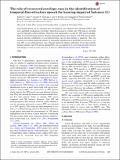The role of recovered envelope cues in the identification of temporal-fine-structure speech for hearing-impaired listeners
Author(s)
Leger, Agnes C.; Desloge, Joseph G.; Braida, Louis D.; Swaminathan, Jayaganesh
DownloadBraida_The role.pdf (191.6Kb)
PUBLISHER_POLICY
Publisher Policy
Article is made available in accordance with the publisher's policy and may be subject to US copyright law. Please refer to the publisher's site for terms of use.
Terms of use
Metadata
Show full item recordAbstract
Narrowband speech can be separated into fast temporal cues [temporal fine structure (TFS)], and slow amplitude modulations (envelope). Speech processed to contain only TFS leads to envelope recovery through cochlear filtering, which has been suggested to account for TFS-speech intelligibility for normal-hearing listeners. Hearing-impaired listeners have deficits with TFS-speech identification, but the contribution of recovered-envelope cues to these deficits is unknown. This was assessed for hearing-impaired listeners by measuring identification of disyllables processed to contain TFS or recovered-envelope cues. Hearing-impaired listeners performed worse than normal-hearing listeners, but TFS-speech intelligibility was accounted for by recovered-envelope cues for both groups.
Date issued
2015-01Department
Massachusetts Institute of Technology. Department of Electrical Engineering and Computer Science; Massachusetts Institute of Technology. Research Laboratory of ElectronicsJournal
The Journal of the Acoustical Society of America
Publisher
Acoustical Society of America (ASA)
Citation
Leger, Agnes C., Joseph G. Desloge, Louis D. Braida, and Jayaganesh Swaminathan. “The Role of Recovered Envelope Cues in the Identification of Temporal-Fine-Structure Speech for Hearing-Impaired Listeners.” J. Acoust. Soc. Am. 137, no. 1 (January 2015): 505–508. © 2015 Acoustical Society of America
Version: Final published version
ISSN
0001-4966